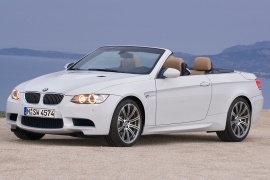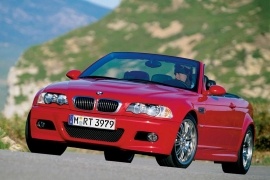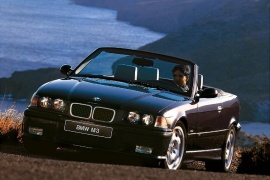BMW M3 Cabriolet Models/Series Timeline, Specifications & Photos
First production year: 1994
Engines: Gasoline
Body style: Convertible (spider/spyder, cabrio/cabriolet, drop/open/soft top)
The 2007 BMW M3 was the last naturally aspirated M3 and the first that featured a V8-engine under the hood, apart from the very limited edition of the 2001 BMW M3 GTR.
The fourth generation of the BMW M3 was announced right from the start to be available in three body choices: sedan, coupe and convertible. The later, named E93 on the BMW internal coding, featured a retractable hard-top that added some weight to the car but improved the fun factor.
Unlike the regular 3-Series convertible, the M3 featured a different bumper with big air-intakes. On the hood, the manufacturer had to put a bulge to install the big, tall, V8 engine, which was higher than the inline-six unit on the rest of the 3-Series. The hood featured two air-vents on each side of the bulge, but only one was functional. Another pair of air-vents were on the side of the car, behind the front wheels, to extract the air from the wheel well. At the back of the car, there were four round exhaust and a diffuser between them. The three-piece hard-top could have been retracted in 22 seconds.
Inside, the M3 convertible offered the same space as in any regular 3-Series Convertible. Due to its longer wheelbase than its predecessor, it offered enough legroom for the rear passengers, but only two seats.
Under the hood, there was a 4.0-liter V8 naturally aspirated engine. It was mated to either a 6-speed manual or a 7-speed automated gearbox. The latter had a better 0-100 kph (0-62mph) time due to a faster gear change time.
The third generation of the M3 was built in a choice of two body styles: coupe and convertible. Even though the convertible was heavier, its performances were no joke.
The first generation of the BMW M3 was a race-purpose car built for streets to receive the FIA approval for racing. Its commercial success was so big that the car-maker decided to build offer M3 versions for the following 3-Series vehicles. The 2001 M3 (E46) was the third generation. While the E30 M3 was built in a little over 17.000 units, the E46 M3 convertible alone was sold in almost 30.000 units.
The aggressive look of the car was due to its rounded parking lights, named “Angel Eyes” even though they looked from the opposing team. The big bumper with a lower apron and wide grille was needed to hide the big radiator and various coolers. Two scoops on the hood allowed a part of the hot air to escape from the engine bay. On the sides, a pair of vents on the front fenders resembled, in a modern way, those found on the glorious BMW 507. The car featured a thicker A-pillar to reinforce the bodywork. From there on there was no other visible reinforcement on top of the body.
Inside, the M3 Convertible offered room for four occupants. The front bucket seats were fitted as standard. In the back, there was not too much room for long trips. The soft-top was completely retractable behind the rear bench. The dashboard and the center console were the same as for the coupe version.
Under the hood, the M3 Cabriolet was fitted with the same 3.2-liter S54 engine mated to a standard 6-speed manual. As an option, there was a 6-speed automated gearbox named SMGII, with a single-clutch system.
BMW introduced the second generation of the M3 in 1992 but waited for another two years before unveiling the open-top version for it.
The German carmaker introduced the third generation of the 3 Series in 1990, and its fanbase waited for the M3 version for another two years. Unlike its predecessor, who sported an inline-four, the E36 M3 boasted a six-cylinder powerplant. Although the open-top version of the regular 3 Series appeared in 1993, the carmaker waited for 1994 to unveil the M3 convertible.
Sharing its front fascia with the M3 Coupe, the Convertible version featured a lower air-dam that featured a center air-intake flanked by the rectangular foglights mounted on the sides, on separate clusters. On the sides, the carmaker added the M-specific aerodynamic package that showed sculptured side skirts profiled to lower the drag. At the back, BMW installed a black diffuser under the rear bumper and placed the dual exhaust on the left side of the car. Unlike the E30 M3 Convertible, which looked radical compared to the regular E30 Convertible, the E36 was more subtle.
Inside, the car was fitted with a pair of high-bolstered bucket seats at the front, separated by the transmission tunnel and the gearbox. The curved dashboard featured an instrument cluster similar to the one installed on the lower-spec 3 Series versions. At the back, the carmaker installed a bench fit for two, and it even underlined that by offering just two headrests.
Under the hood, the 3.2-liter inline-six was paired to a five-speed manual, but that was changed starting with the 1995 model-year when BMW introduced a heavily modified facelift for the E36.


